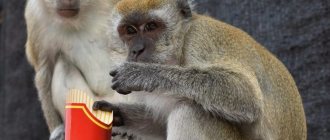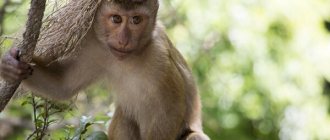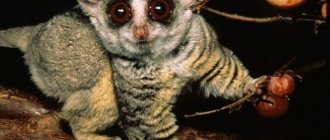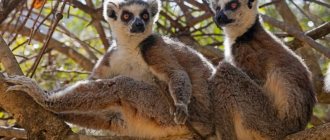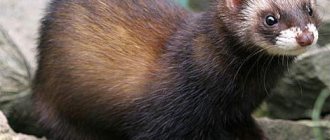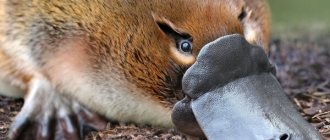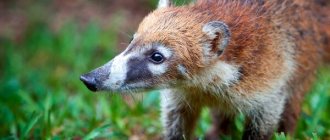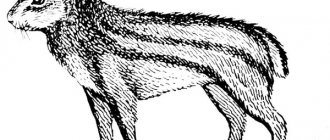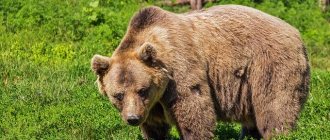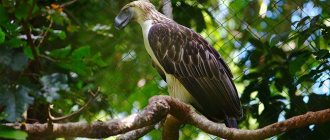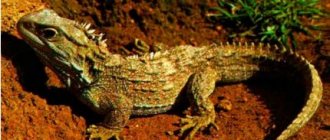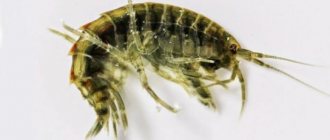Primates are an order included in the class of mammals, a type of chordate animal (subphylum vertebrates). The class of mammals is characterized by viviparity, feeding the baby with milk, and carrying it in the uterus. All representatives of this class are homeothermic, that is, their body temperature is constant. In addition, their metabolic rate is high. In addition to the middle and inner ears, all mammals also have an outer ear. Females have mammary glands.
Primates (prosimians and monkeys) of all mammals are distinguished by perhaps the greatest richness and diversity of forms. However, despite the differences between them, many structural features of their bodies are similar. They were developed in a long process of evolution as a result of an arboreal lifestyle.
Primate limbs
Primates are animals with a well-developed five-fingered grasping limb. It is adapted for representatives of this order to climb tree branches. They all have a clavicle and a completely separated ulna and radius, allowing for a variety of movements and forelimb mobility. The thumb is also movable. In many species it can be contrasted with others. The terminal phalanges of the fingers are equipped with nails. In primate forms that have clawed nails, or those that have claws on only some of the digits, the thumb is characterized by the presence of a flat nail.
Many species of monkeys are excellent acrobats
They are known for their complex tree jumps that even the best acrobats cannot replicate! Many monkey species use the hand-in-hand technique. Colobus, unlike other species of monkeys, has hind legs that are much longer than the front ones, which provides it with the ability to move at high speed.
Monkeys' legs are as flexible as their arms, which helps them navigate small branches high in the rainforest canopy. Some species can swim; their webbed toes help them swim across streams and rivers. However, this feature makes them vulnerable to crocodiles and alligators, which skillfully blend into their environment.
The structure of primates
When moving on the surface of the earth, they rely on the entire foot. In primates, arboreal life is associated with a reduction in the sense of smell, as well as good development of the organs of hearing and vision. They have 3-4 nasal turbinates. Primates are mammals whose eyes are directed forward, the orbits are separated from the temporal fossa by a periorbital ring (lemurs, tupai), or by a bony septum (monkeys, tarsiers). Lower primates have 4-5 groups of vibrissae (tactile hairs) on their faces, while higher primates have 2-3. In monkeys, just like in humans, skin ridges are developed over the entire plantar and palmar surface. However, prosimians have them only on their pads. The variety of functions that the forelimbs have, as well as the active life of primates, led to the strong development of their brain. And this means an increase in the volume of the cranium in these animals. However, only higher primates have large, well-developed brain hemispheres with many convolutions and sulci. The lower ones have a smooth brain, with few convolutions and grooves.
Capuchins know how to use tools
Most apes can solve complex problems and learn from experience, but the cognitive level of great apes is beyond their reach. Some of the first non-primate monkeys to learn to use tools in the wild were capuchins. According to archaeological studies of Capuchin stone tools, wild bearded capuchins were using tools more than 3,000 years ago. During this time, their ability to use tools evolved. This skill was previously attributed only to humans and primates.
Photo: Dorit Bar-Zakay
The most common example of intelligent tool use among capuchins is the way they crack nuts. They first place them on stone "anvils" and then hit them hard with another stone. According to archaeological research, Capuchins adjusted the size of their tools over time, using smaller stones for seeds and softer nuts. Another remarkable example of capuchin intelligence is the way they rub crushed centipedes on their bodies to repel mosquitoes and other insects.
Body measurements
There are significant variations in the body size of representatives of this order. The smallest primates are mouse lemurs, while gorillas grow to 180 cm or more. The body mass of males and females differs - males are usually larger, although there are many exceptions to this rule. The family of some monkeys consists of several females and a male. Since body weight is an advantage for the latter, natural selection occurs associated with its increase. For example, a male Hanuman can gather a whole harem consisting of 20 females - a very large family. Primates are forced to protect their harem from other males. In this case, the body weight of the owner of the family reaches 160% of the female’s weight. In other species in which males usually mate with only one female (for example, gibbons), representatives of different sexes do not differ in size. Sexual dimorphism is very weakly expressed in lemurs.
When fighting for paternity, not only body size plays an important role in such a group as primates. These are animals whose fangs serve as powerful weapons. Males use them in aggressive displays and fights.
Current state
For a long time, humans have been exterminated for meat and skins. Its appearance is associated with the extinction of several endemic P. species in Madagascar and the Antilles. Nowadays, P. is hunted by the indigenous peoples of the South-East. Asia, West Africa and South America. Hunting by local residents has brought the red beetle (Piliocolobus badius) to the brink of extinction in Western Europe. Africa, one of the subspecies of which is probably already extinct. Eating monkey meat is prohibited in Hinduism, Buddhism, and Islam (in India, monkeys are considered sacred animals). Tens of thousands of P. are used annually in scientific research. institutions for medical and biological experiments as the species closest to humans. Most of them are bred in special. primatological centers (farms). Before the emergence of such centers in the 1950s–70s. catching monkeys for honey experiments led to disaster. reduction in the number of many populations (primarily macaques and chimpanzees). Only in the USA in the 1950s. 200 thousand individuals of P. were imported annually. Trade in all types of P. is regulated by the International Convention. Trade in Endangered Species of Wild Fauna and Flora (CITES); trade in 50 species and subspecies of P. is completely prohibited. In nature, the population size of most P. species is steadily declining. arr. due to human destruction of their habitats. A particular threat to P. is posed by barbaric tropical fellings. forests in Brazil, Indonesia and Madagascar. Development of tantalite ore in Democratic. Republic of the Congo and civil. Wars over control of mines are causing serious damage to Western gorilla (Gorilla gorilla) populations. More than a third of P. species are listed in the IUCN Red List as vulnerable or endangered (21 species). The rarest species of P. are the silky sifaka (Propithecus candidus), Delacour's langur (Trachypithecus delacouri), white-headed langur (T. poliocephalus), gray-bellied tonko (Pygathrix cinerea) and Tonkinese rhinopithecus (Rhinopithecus avunculus). See also Apes.
Primate reproduction and offspring
Primates breed all year round. Usually one cub is born (in lower forms there may be 2-3). Large species of primates reproduce less frequently, but live longer than their smaller relatives.
Already at the age of one year, mouse lemurs are able to reproduce. Every year two cubs are born. The body weight of each of them is about 6.5 g. Pregnancy lasts 2 months. 15 years is the longevity record for this species. The female gorilla, on the contrary, becomes sexually mature only at the age of 10. One calf is born, whose body weight is 2.1 kg. Pregnancy lasts 9 months, after which a second pregnancy can occur only after 4 years. Gorillas typically live up to 40 years.
What is common to different species of monkeys, with significant differences in species, is a small number of offspring. The growth rates of young animals in representatives of this order are very low, much lower than those observed in other mammals with similar body mass. It is difficult to say what is the reason for this feature. Perhaps it should be looked for in brain size. The fact is that the most energy-intensive tissues in the body are the brain tissues. In large primates, a high level of metabolism is observed in it, which reduces the rate of development of reproductive organs, as well as body growth.
Pygmy marmosets are the smallest monkeys in the world
Photo: www.monkeyworlds.com
This tiny New World monkey, native to the Amazon basin of South America, is about 12.5 cm long and weighs about 110 grams when mature. Pygmy marmosets live in groups of two to six individuals, and monogamous pairs share parental duties. Females give birth to one to three cubs, among which twins are common. Although the pygmy marmoset is the tiniest monkey, the award for smallest living primate goes to Madame Berthe's mouse lemur.
Classification of primates
There are approximately 200 known species of living primates. There are 2 suborders (monkeys and prosimians), 12 families and 57 genera. According to the classification, the most common at present, the order of primates includes tupayas, forming an independent family. These primates, together with tarsiers and lemurs, form a suborder of prosimians. They connect insectivorous animals with modern primates through lemurs, recalling what kind of ancestors the latter had in ancient times.
Monkeys are omnivores
Monkey tails are very useful for collecting flowers, fruits, nuts, leaves, seeds, insects, bird eggs, spiders and small mammals. Old World monkeys fill their large cheek pouches with fruits, leaves, and insects throughout the day, periodically stopping in a safe area to chew and swallow the collected food. It has also been established that baboons eat meat when they manage to catch a young antelope, rabbit or bird. Colobus monkeys and langurs prefer a leafy diet.
Primates: evolution
It is believed that the ancestors of modern primates were insectivorous primitive mammals, similar to the tupai that exist today. Their remains were found in Mongolia, in Upper Cretaceous deposits. Apparently, these ancient species lived in Asia, from which they spread to other places in North America and the Old World. Here these primates developed into lankers and lemurs. The evolution of the original forms of monkeys of the Old and New Worlds, apparently, was from primitive lankers (some authors consider ancient lemurs to be the ancestors of monkeys). American primates arose independently of the monkeys found in the Old World. Their ancestors from North America penetrated into South America. Here they specialized and developed, adapting to an exclusively arboreal lifestyle. In many biological and anatomical traits, humans are higher primates. We constitute a separate family of people with the genus man and only one species - modern sapiens.
Hominoidea (humanoids)
This superfamily includes three families of tailless primates: Hylobatidae (gibbons), Pongidae (apes), and Hominidae (humans). The similarity between them is no less than within the groups of canine and broad-nosed monkeys: the dental systems, brain structure, placenta, embryonic development and even serological reactions are very similar. Fossil forms that may have given rise to the entire superfamily are known from Egypt and date to the Lower Oligocene (Propliopithecus); the oldest remains of gibbons were discovered in the Miocene deposits of Central Europe; early apes are represented by many finds of Miocene and Pliocene age (Dryopithecus and Sivapithecus), and the genus Paleosimia, very similar to modern orangutans, is described from the Siwalik Formation (Upper Miocene) in northern India.
Practical significance of primates
Modern primates are of very great practical importance. Since ancient times, they have attracted human attention as funny living creatures. Monkeys were the subject of hunting. In addition, these mammals were put up for sale for home entertainment or in the zoo. Primates are even eaten as food these days! Aborigines still eat the meat of many monkeys today. The meat of prosimians is also considered very tasty. Skins of certain species are used today for making various things.
The order Primates has become increasingly important in medical and biological experiments in recent years. These animals show great similarities with humans in many anatomical and physiological characteristics. Moreover, not only anthropoid primates have this similarity, but also lower ones. Representatives of this order are even susceptible to the same diseases as us (tuberculosis, dysentery, diphtheria, polio, tonsillitis, measles, etc.), which generally proceed in the same way as ours. That is why some of their organs are used today in the treatment of people (in particular, the kidneys of green monkeys, macaques and other monkeys are a nutrient medium for growing viruses, which, after appropriate processing, are then turned into a vaccine against polio).
Monkeys live mainly in tropical forests
Most monkey species are found in the tropical forests of Asia, Africa, Central and South America, or the African savannas. Gelada and Roxellan's rhinopithecus are mountain dwellers, while Japanese macaques live in snowy areas of Japan and spend a lot of time in hot springs in winter. Baboons live in savannas, open woodlands and rocky slopes.
Most monkeys are arboreal, although some species, such as macaques, baboons and a number of mangabeys, are terrestrial, although they can climb trees.
Some species of monkeys give birth to babies with completely different colors.
Photo: Joshua J. Cotten
For example, adult colobus monkeys have black hair, while newborns have white hair; baby langurs have orange fur, while their parents have black fur. This color difference is believed to help the group identify their young. The color of the hatchlings usually changes during the first six months, when the young become almost perfect copies of the adults.
Uakari
Uakari monkeys have a memorable appearance: they have a large human-like face, completely devoid of hair. Uakari belong to the family of prehensile-tailed monkeys. The bald and red uakari have a red or pink complexion. When a monkey gets angry, his face turns purple, like a human's. Even small ears are shaped like human ones. Uakari are widespread in the Orinoco and Amazon river basins. They prefer to settle at the very top of huge tropical trees; they are distinguished by their secretive and cautious disposition. There are few uakari left in natural conditions, so all species are under protection.
see also
Monkey:
- Quotes on Wikiquote
- Media files on Wikimedia Commons
- Great Apes Project
- Teaching Monkeys to Speech
- Chimpanzee intelligence
- Infinite Monkey Theorem
- “Monkey game” is a conventional name in chess for a series of moves in a game when one of the opponents mirrors the moves of the other.
- Three monkeys - a religious and philosophical symbol
- Monkey Monument
- Four-armed
- Darwinius masillae
- Eosimias
